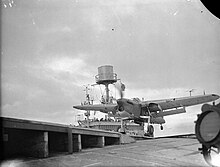
827 Naval Air Squadron

| 827 Naval Air Squadron | |
|---|---|
 An 827 Squadron Fairey Barracuda taking off from HMS Furious during the Operation Mascot attack on the German battleship Tirpitz in July 1944 | |
| Country | |
| Branch | |
| Role | Attack |
| Size | Squadron |
| Part of | Fleet Air Arm |
| Commanders | |
| Notable commanders | Lieutenant Commander J R Godley; Lieutenant Commander Roy Baker-Falkner |
| Aircraft flown | |
| Attack | Fairey Barracuda |
| Fighter | Westland Wyvern |
827 Naval Air Squadron was an aircraft squadron of the Royal Navy's Fleet Air Arm during the Second World War.

It operated Fairey Barracudas starting in May 1943, becoming the first squadron to receive the Fairey Barracuda in any substantial number, and was led by Strike leader Roy Sydney Baker-Falkner in the attack on the German battleship Tirpitz in Operation Tungsten in 3 April 1944. Post-war it initially operated the Blackburn Firebrand strike fighter, until 1954 when the squadron began operating Westland Wyverns.[1]

Citations
- ^ Sturtivant, pp. 279–281
Bibliography
- Sturtivant, Ray (1984). The Squadrons of the Fleet Air Arm. Tonbridge, Uk: Air-Britain (Historians). ISBN 0-85130-120-7.
See what we do next...
OR
By submitting your email or phone number, you're giving mschf permission to send you email and/or recurring marketing texts. Data rates may apply. Text stop to cancel, help for help.
Success: You're subscribed now !
